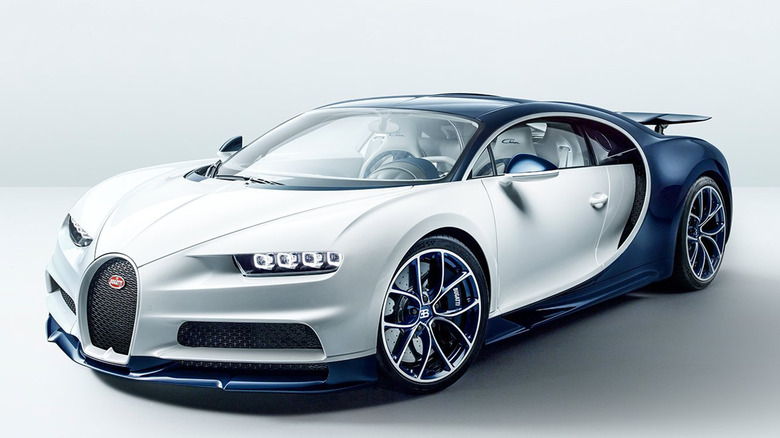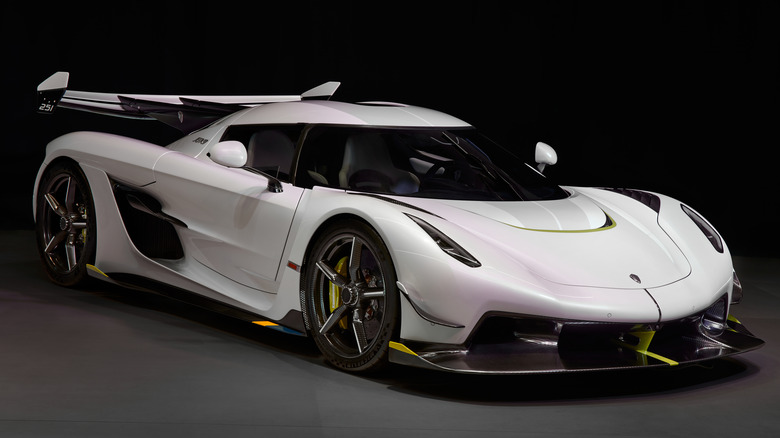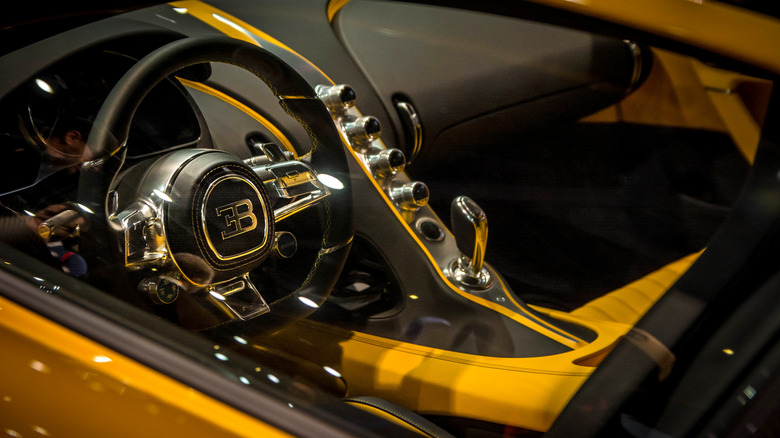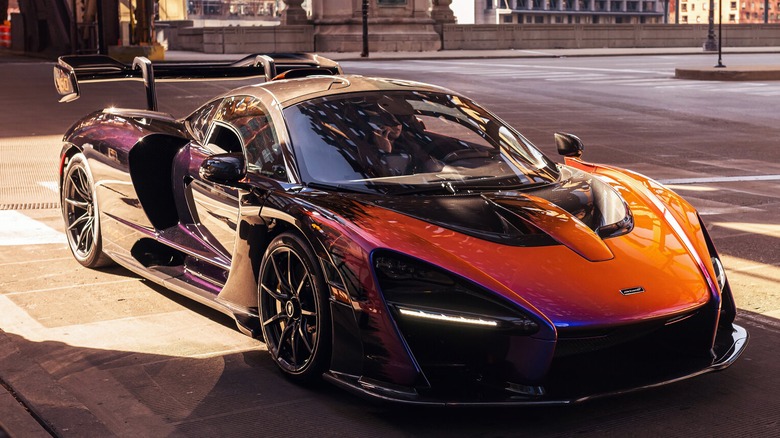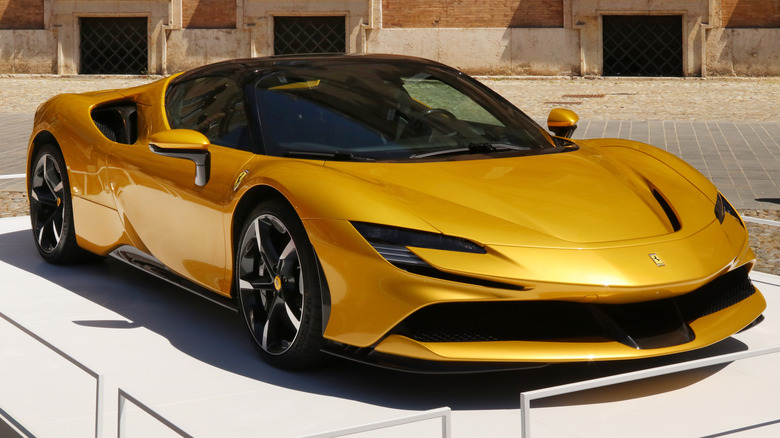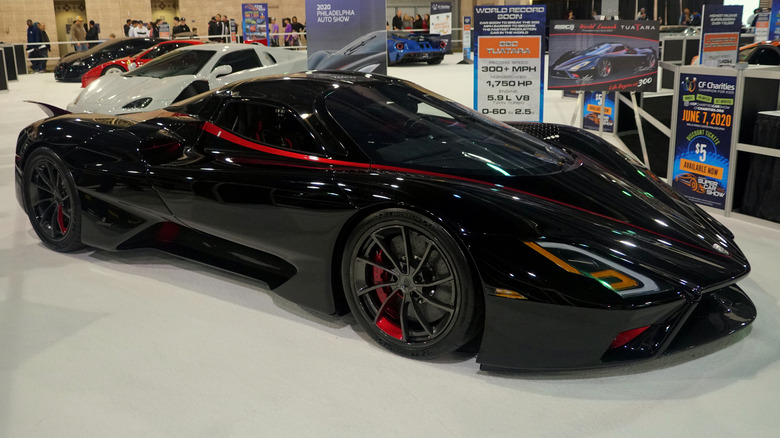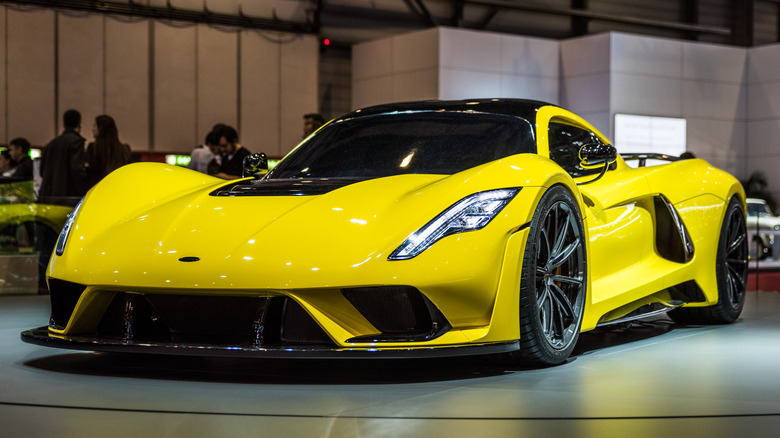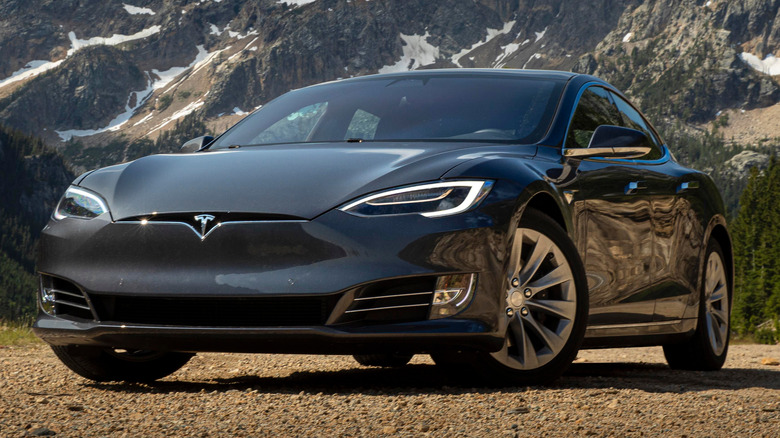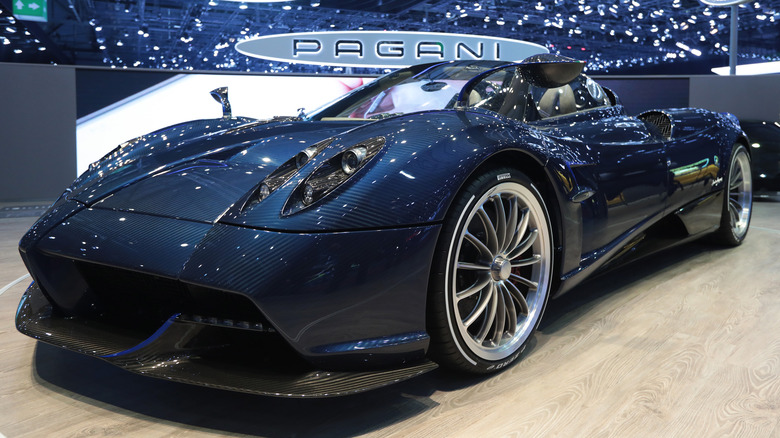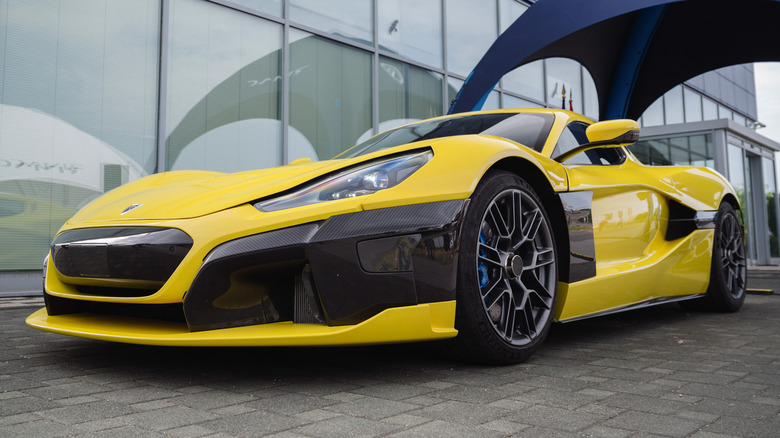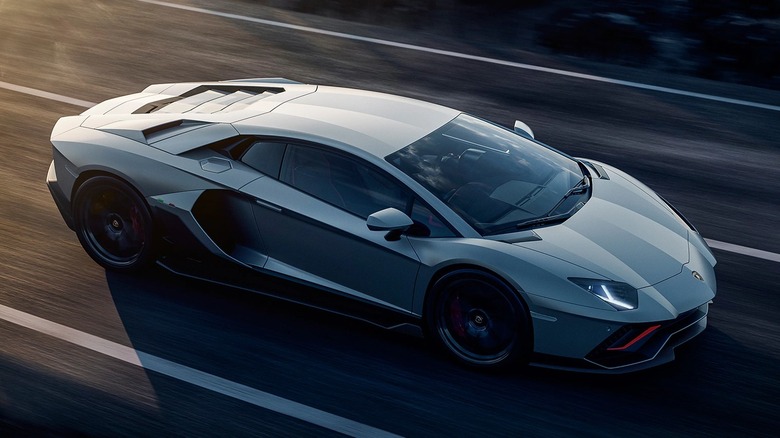The 10 Fastest Production Cars In The World Right Now
Competition is an integral part of the human spirit and drives both innovation and exploration. Indeed, this penchant for competition goes down to base survival instinct in vying for limited resources of food and water (via the University of Texas). In the modern age, competition takes many forms, from sports to academics to racing. Humans have been racing for millennia on foot and horseback, and in the 1900s, the automobile expanded the ability to reach the highest of speeds in the pursuit of brinksmanship.
Unfortunately for most, experiencing the rush of traveling above and beyond any designated roadway speed limit must be done vicariously through professional drivers. For others, that experience is available through one of many publicly available machines from manufacturers competing in their own race against each other to produce the fastest automobile. Generally, only the privileged few who can afford such machines are fortunate to gain that experience, but as long as the right buyers exist, manufacturers will deliver. While the bar is ever-increasing, and the parameters with which to measure top performance vary, these 10 cars are the fastest vehicles, according to the manufacturers' websites, currently available for sale today.
Koenigsegg Jesko Absolut - V8, 5.1 L, twin turbochargers
In its short history, Koenigsegg has produced some of the most impressive and technologically advanced supercars in the world. While many boutique car makers have come and gone, producing vehicles with impressive stats but disappointing quality or sales, Koenigsegg knows how to deliver with staying power. Almost 20 years after its inception in 1994, this Swedish company continues to deliver the finest of exotic vehicles in Europe.
Its latest sports car, the Jesko, is the culmination of years of experience producing the most extreme engineered supercars in the world, and melding technology at the pinnacle of high performance into their current offering. The top-performing model, the Jesko Absolut, is outfitted with a twin-turbo V8 engine running through an in-house developed nine-speed transmission developing 1,280 horsepower to the rear wheels. The Jesko Absolut can reach a top speed of 330 miles per hour (mph). However, as founder Christian von Koenigsegg told Car and Driver, he has no access to a facility in which they could safely test the car to such extreme limits.
Bugatti Chiron Super Sport - W16, 8.0L, quad turbochargers
With a heritage dating back to 1909, the Bugatti Chiron is responsible for holding up an impressive pedigree. The current flagship of Bugatti Automobiles, the Chiron, is as opulent as it is powerful. It also takes a seat as the halo vehicle for the entire Volkswagen Group, the owner of the Bugatti label since 1998. The Chiron follows up the Veyron, the successful VW project creating the most outlandish sports car ever built. With the development of the Veyron, the goal was to create a car that can reach a top speed of 407 km/h (252 mph). With such a lofty goal attained from a first run, it should be no surprise that VW would want to break its current record. The Robb Report initially reported the Chiron would go on sale in late 2016, powered by the same quad-turbo W16 engine as its predecessor, with upwards of 1,500 horsepower driving all four wheels.
The Chiron is a serious car and, according to the manufacturer, the Super Sport edition accelerates to 124 mph in 5.5 seconds. The top speed is electronically limited to 273.4 mph, and Bugatti says the body and frame have been specifically designed to withstand the extreme pressures experienced at these speeds. A highly limited edition Chiron Super Sport 300+ achieved a world record-breaking speed of 304.77 mph by Bugatti's test driver, Andy Wallace, in 2019, the company noted.
McLaren Senna GTR LM - V8, 4.0L, twin turbochargers
When one is asked about the ultimate king of speed among cars from the 1990s, the undisputed champion is the McLaren F1. Built by a winning racing team as its first entry into the consumer market, the F1 set new benchmarks in nearly every way, from flat-out performance to style (via Top Speed). Today, the F1 is one of the most coveted classic supercars and when one comes up for auction today, final bids can exceed 20 million dollars, CNBC notes. McLaren has since built upon its success and expanded into a regular automaker of ultra-high-end performance supercars. In their stable are several models that continue in the tradition set by the F1, and several that endeavor to exceed the previous benchmarks.
One such vehicle is the Senna, a halo car named as a tribute to one of McLaren Racing's most successful drivers, Ayrton Senna. Created as an all-out performance beast, the Senna delivers 789 horsepower from a twin-turbocharged V8 through a seven-speed dual-clutch transaxle. The carbon-fiber structure of the body and chassis weighs in at a scant 2,897 pounds and reaches 100 km/h from a standstill in just 2.8 seconds, according to Auto Evolution. The power-to-weight ratio along with its chassis engineering makes the Senna one of the fastest road-legal cars around a track.
Ferrari SF90 Stradale - V8, 4.0L, twin turbochargers, PHEV 3 motors
Ferrari, the Italian automotive brand represented by a prancing horse on a yellow background, generally needs no introduction. As the oldest supercar producer in the world, Ferrari enjoys wide-ranging brand recognition and its cars have a long history rooted from the beginning in winning auto races. The brand has set many records over the years as well as produced some of the most beautiful creations in the automotive industry (via Autosport). However, they have not achieved such legendary status by resting on laurels. Ferrari is well known for its ultra-special limited series performance cars, such as the F40, F50, and the La Ferrari. They produce a car meant for "la creme de la creme" about once per decade, and the current car is the SF90 Stradale.
The SF90 features a twin-turbo 4.0L V8 coupled with 3 electric motors and a 7.9kWh lithium-ion battery, making it a hybrid, according to Road and Track. This setup allows for a car that Ferrari says will achieve 0 to 60 mph in 2.5 seconds from its engine power output of 769hp, plus it has electric motor output of 217 horsepower, making the total output nearly 1,000 horsepower, an impressive figure for a hybrid. Furthermore, due to its hybrid arrangement, it can power itself up to 25 km on battery alone. In real-world testing, Motor Trend says all this high output technology makes the SF90 good for a top track speed of 211mph.
SSC Tuatara Aggressor - V8, 5.9L, Twin Turbocharging
Talks of supercars and blazingly fast acceleration often spotlight the most exotic machines Europe has to offer, but that is no reason to keep the Americans on the sidelines. Our very own SSC North America has a few tricks up its sleeve in the elegant, striking, and blisteringly quick Tuatara. While SSC tends to be left out of the spotlight on most speed runs, it is not for lack of merit. SSC founder Jerod Shelby started his company in 1998 and has been quietly building cars to compete with the best of the Italian supercars, per Supercars.net.
Their newest model, the Tuatara, could have taken that title from Bugatti once again if not for the discrepancies of establishing the official record. Official record or not, it is safe to say the car is fast. Shelby enlisted the expertise of Nelson Racing Engines to create the high-tech mill powering the Tuatara and, according to Motor Trend, it is packed full of unique engineering and technical design to make it competitive among the fastest cars in the world. The top-speed-oriented model, the Tuatara Aggressor, is powered by a twin-turbo pushrod V8 producing 1,350 horsepower on 91 octane pump gas and directs that power through a seven-speed dual-clutch transmission that SSC claims to be capable of shifts in less than 100 milliseconds. The Tuatara's good looks and luxurious interior are a bonus.
Hennessey Venom F5 - V8, 6.6l, twin turbocharging
Another homegrown American race car hero, Hennessey Performance Engineering, has been for decades modifying factory sports cars and trucks, testing the limits of what American iron can do with enough know-how and money. For the past 30 years, Hennessey Performance has been wrenching on just about anything brought their way to squeeze gobs of power out of them. While a bulk of their work appears to be American muscle, they do not shy away from European exotics. Hennessey's first foray into automotive development started with a highly modified Lotus Exige body and chassis, stretched to accommodate a 427 cu. In. V8 pumping out more than 1000 horsepower with the intent of breaking top speed records, which it did in 2016.
Following the success of the Venom GT, Hennessey decided to produce their own ground-up design and bless us with the newest, fastest kid from Texas, the Hennessey Venom F5. It is named for the highest classification of tornado on the Fujita scale, F5. The heart of the F5 is a 6.6L twin-turbo V8 nestled amidships into a car tipping the scales at just under 3,000 pounds, resulting in a power to weight ratio of 1,298 per ton. Hennessey claims the F5 top speed of 311 mph and an acceleration time of 0-60 in 2.6 seconds and there is little doubt that once the official tallies are in, the F5 will be a competitor for the crown (via Car and Driver).
Tesla Model S Plaid - Full electric, 3 motor
While some of the most exotic, fastest cars on the planet may only be familiar to aficionados and gearheads, Tesla needs no introduction. As the world's first electric-only mass-produced vehicle manufacturer, Tesla has achieved many firsts not only in the auto industry but the tech industry as well. One of these firsts is the introduction of a sedan that competes with the likes of Ferrari and Lamborghini in the performance category. When Tesla announced the Models S Plaid, it created a deserved buzz. The groundbreaking Plaid comes equipped with three electric motors driven by enough electrons to produce 1,020 horsepower and still achieve a range of just under 400 miles per charge.
The advantage of having this kind of power delivered from electric motors to all four wheels is that electric torque is available instantly. Where a gas-powered engine must rev up to increase its power through the rev range, electric motors deliver all their power at once. This makes the car not only capable of an incredible top speed, but the acceleration is flat out fast. Tesla claims its 0-60 time is just 1.99 seconds and a top speed of 200 mph, however, CNet discusses how the electronic software limitations of the car keep it from moving faster than 175 mph. While this does not put in the absolute fastest of fast cars, the acceleration is second to none, and it surely holds its own on a drag strip anywhere.
Pagani Huarya R - V12, 6L, naturally aspirated
Horacio Pagani has had a long and fruitful career, including a productive stint in the design and development department of Lamborghini. Since he broke out on his own, the resulting vehicles have been examples of what happens when the envelope of engineering and design is pushed to the edge. His first endeavor, the Zonda, was powered by an AMG-built Mercedes-Benz V12 and set its own standard for automotive beauty and engineering. Pagani vehicles achieve blazing fast speed with pure displacement and no forced induction. In a world where companies using turbos or superchargers to boost horsepower are the norm, Pagani sticks to tradition while bucking it at the same time.
While the Huayra uses the same AMG V12, the track-focused Huayra R uses a custom-designed V12 built by HWA engineering to produce 850 horsepower to the rear wheels, and the carbon fiber chassis and abundance of lightweight components keep weight dialed in at just over 2,300 pounds. The HWA engine and other R-specific changes raise the price over the standard Huarya by about a million dollars to $3.5 million. It is not a car for the faint of heart — or pocketbook. There are no official figures on performance specs, but Pagani estimates the R will hit 60 mph in three seconds and top out at 240 mph.
Rimac Nevera - Full electric, 4 motors
Rimac, the newcomer from Croatia, seeks to dominate the electric hypercar market despite hailing from a country with little history of automating. It seems apt that an all-electric, high-performance automobile setting new standards for sports cars would share the same home country as one of the most important pioneers of electric technology, Nikola Tesla. Like Nikola Tesla, the founder of Rimac, Mate Rimac, seems to have difficulty keeping good ideas confined to his head. According to Top Gear, he is a fountain of ideas with the drive and tenacity to keep them flowing.
The specs of the Nevera are impressive. The AWD two-seater Nevera is powered by motors on all four wheels that combine to produce an astonishing 1,914 horsepower. The torque available is from an electric drive train. The claimed top speed of 258 mph and the 0 to 60 mph time is just 1.85 seconds. While the performance of the car is certainly most impressive, equally so is the production of nearly every bespoke part being done in-house. The software, batteries, controllers, knobs, switches, and more are all produced in a factory on the outskirts of Zagreb. Rimac is taking orders for the Nevera and plans to produce 50 units per year for the next three years at a cost of around two million dollars. Once it is tested to official parameters, this will likely be the fastest production car in the world.
2021 Lamborghini Aventador LP 780-4 Ultimae
Ever since Ferruccio Lamborghini decided to build high-performance sports cars more than 5 decades ago, his company has churned out some of the fastest and most desirable cars in the world. The pinnacle of performance for Lamborghini is the Aventador LP 780-4 Ultimae, the sendoff for the line as the Aventador will be replaced by a new model next year.
Launched in 2011, the Aventador featured garishly wild styling with a 690 horsepower 6.5-liter V12 longitudinally-mounted engine. Following the release, Lamborghini has produced several special models with upgrades in styling and performance, but the final special edition is the Ultimae.
According to the manufacturer, power output has been increased to 770 horsepower and it achieves performance figures of 0-60 mph in just 2.8 seconds with a top speed of 220 mph, making it the fastest Lambo on sale today. It is in close company though, as the 0-60 time is only .1 second slower than the debut model, and a few one-offs and special-edition cars of the past have gone ever so slightly faster.
Regardless, it is a blistering fast supercar with classic Lamborghini drool-worthy styling that is sure to tickle all the right places for anyone who has the money to get one.
